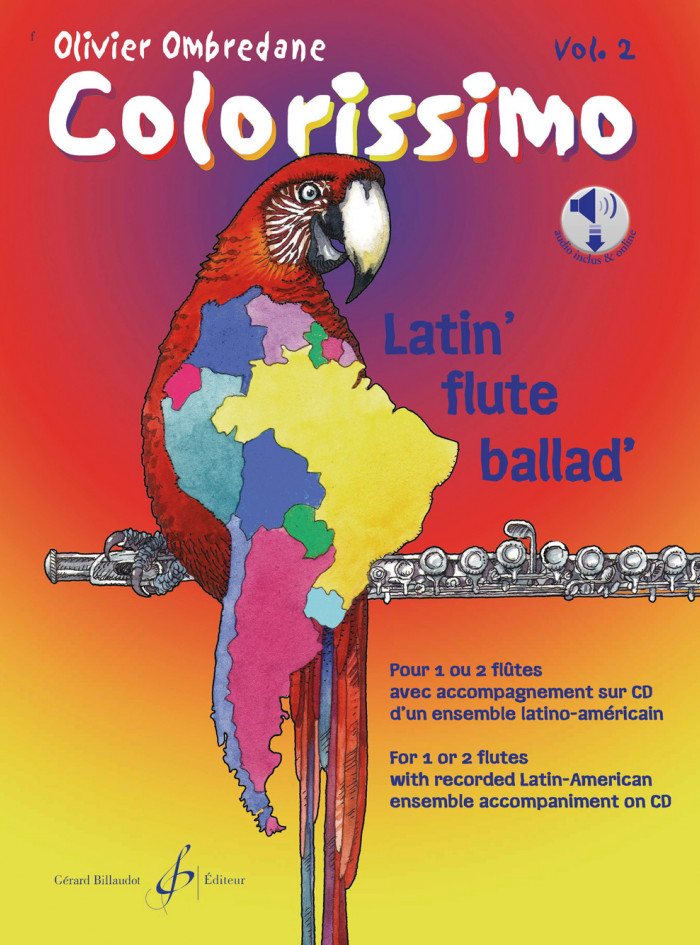

Colorissimo - volume 2
Colorissimo, latin' flute ballad' is a collection of original cornpositions offering a large selection of pieces inspired by traditional and popular Latin-American and Caribbean rhythms and beats. From the altiplano (Peruvian Huayno, Bolivian Takirari), the Pacifie or the Atlantic coast (Columbian Cumbia, Argentinian Milonga), or from the Caribbean islands (Cuban Bolero, jamaïcan Reggae), these colorful, swaying melodies undoubtedly have great pedagogical potential.
In accordance with traditional oral transmission practice, we invite teachers and students to make use of the accompanying CD in order to memorize the music through active listening, singing etc.
Playing along with the playback soundtrack, with/without the written material, will help control and improve perfect sync.
Moreover, singing their part and simultaneously clapping the specific rhythms of the pieces, students have an opportunity to develop their musical abilities beyond mere instrumental technique. Further practice may include stomping the beat as well.
N.B.: The more complex 2nd part, often suggestive of the playback rhythm, enables the teacher to accompany the upper voice (with or without playback) and express the rhythmic specificity of the piece.
Last but not least, our dearest wish is to have you discover and enjoy a particular type of music that is still too little known despite being accessible to all!
Colorissimo - volume 2
Colorissimo, latin' flute ballad' is a collection of original cornpositions offering a large selection of pieces inspired by traditional and popular Latin-American and Caribbean rhythms and beats. From the altiplano (Peruvian Huayno, Bolivian Takirari), the Pacifie or the Atlantic coast (Columbian Cumbia, Argentinian Milonga), or from the Caribbean islands (Cuban Bolero, jamaïcan Reggae), these colorful, swaying melodies undoubtedly have great pedagogical potential.
In accordance with traditional oral transmission practice, we invite teachers and students to make use of the accompanying CD in order to memorize the music through active listening, singing etc.
Playing along with the playback soundtrack, with/without the written material, will help control and improve perfect sync.
Moreover, singing their part and simultaneously clapping the specific rhythms of the pieces, students have an opportunity to develop their musical abilities beyond mere instrumental technique. Further practice may include stomping the beat as well.
N.B.: The more complex 2nd part, often suggestive of the playback rhythm, enables the teacher to accompany the upper voice (with or without playback) and express the rhythmic specificity of the piece.
Last but not least, our dearest wish is to have you discover and enjoy a particular type of music that is still too little known despite being accessible to all!
My account
Forgotten password?I still don’t have an account
Book
| Type | Index | Main track | Other tracks |
|---|---|---|---|
| 02 | Cbossa | ||
| 03 | Abrac | ||
| 04 | Gua cat'small | ||
| 05 | L'enfant vers… | ||
| 06 | Val sans fin | ||
| 07 | Rumba de la cabeza | ||
| 08 | Jaune pourpre | ||
| 09 | Danza iber | ||
| 10 | Ho la le | ||
| 11 | Entre bulles | ||
| 12 | Balade d'o | ||
| 13 | Amusons-nous | ||
| 14 | Ainsi son |
